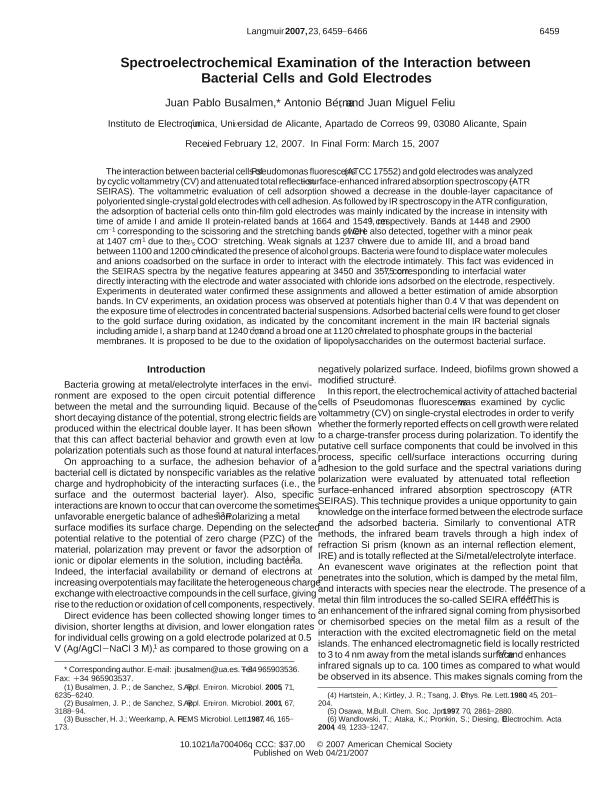Mostrar el registro sencillo del ítem
dc.contributor.author
Busalmen, Juan Pablo

dc.contributor.author
Berna, Antonio
dc.contributor.author
Feliu, Juan Miguel
dc.date.available
2019-03-26T15:47:38Z
dc.date.issued
2007-05
dc.identifier.citation
Busalmen, Juan Pablo; Berna, Antonio; Feliu, Juan Miguel; Spectroelectrochemical examination of the interaction between bacterial cells and gold electrodes; American Chemical Society; Langmuir; 23; 11; 5-2007; 6459-6466
dc.identifier.issn
0743-7463
dc.identifier.uri
http://hdl.handle.net/11336/72537
dc.description.abstract
The interaction between bacterial cells of Pseudomonas fluorescens (ATCC 17552) and gold electrodes was analyzed by cyclic voltammetry (CV) and attenuated total reflection-surface-enhanced infrared absorption spectroscopy (ATR-SEIRAS). The voltammetric evaluation of cell adsorption showed a decrease in the double-layer capacitance of polyoriented single-crystal gold electrodes with cell adhesion. As followed by IR spectroscopy in the ATR configuration, the adsorption of bacterial cells onto thin-film gold electrodes was mainly indicated by the increase in intensity with time of amide I and amide II protein-related bands at 1664 and 1549 cm-1, respectively. Bands at 1448 and 2900 cm-1 corresponding to the scissoring and the stretching bands of CH2 were also detected, together with a minor peak at 1407 cm-1 due to the vs COO- stretching. Weak signals at 1237 cm-1 were due to amide III, and a broad band between 1100 and 1200cm-1 indicated the presence of alcohol groups. Bacteria were found to displace water molecules and anions coadsorbed on the surface in order to interact with the electrode intimately. This fact was evidenced in the SEIRAS spectra by the negative features appearing at 3450 and 3575 cm -1, corresponding to interfacial water directly interacting with the electrode and water associated with chloride ions adsorbed on the electrode, respectively. Experiments in deuterated water confirmed these assignments and allowed a better estimation of amide absorption bands. In CV experiments, an oxidation process was observed at potentials higher than 0.4 V that was dependent on the exposure time of electrodes in concentrated bacterial suspensions. Adsorbed bacterial cells were found to get closer to the gold surface during oxidation, as indicated by the concomitant increment in the main IR bacterial signals including amideI, a sharp band at 1240 cm-1, and a broad one at 1120 cm-1 related to phosphate groups in the bacterial membranes. It is proposed to be due to the oxidation of lipopolysaccharides on the outermost bacterial surface. © 2007 American Chemical Society.
dc.format
application/pdf
dc.language.iso
eng
dc.publisher
American Chemical Society

dc.rights
info:eu-repo/semantics/openAccess
dc.rights.uri
https://creativecommons.org/licenses/by-nc-sa/2.5/ar/
dc.subject
Ir Spectroscopy
dc.subject
Bacterial Adhesion
dc.subject
Interfacial Chemistry
dc.subject.classification
Otras Ciencias Químicas

dc.subject.classification
Ciencias Químicas

dc.subject.classification
CIENCIAS NATURALES Y EXACTAS

dc.title
Spectroelectrochemical examination of the interaction between bacterial cells and gold electrodes
dc.type
info:eu-repo/semantics/article
dc.type
info:ar-repo/semantics/artículo
dc.type
info:eu-repo/semantics/publishedVersion
dc.date.updated
2019-03-15T19:00:50Z
dc.journal.volume
23
dc.journal.number
11
dc.journal.pagination
6459-6466
dc.journal.pais
Estados Unidos

dc.journal.ciudad
Washington
dc.description.fil
Fil: Busalmen, Juan Pablo. Consejo Nacional de Investigaciones Científicas y Técnicas; Argentina. Universidad de Alicante; España
dc.description.fil
Fil: Berna, Antonio. Universidad de Alicante; España
dc.description.fil
Fil: Feliu, Juan Miguel. Universidad de Alicante; España
dc.journal.title
Langmuir

dc.relation.alternativeid
info:eu-repo/semantics/altIdentifier/doi/https://dx.doi.org/10.1021/la700406q
dc.relation.alternativeid
info:eu-repo/semantics/altIdentifier/url/https://pubs.acs.org/doi/10.1021/la700406q
Archivos asociados
